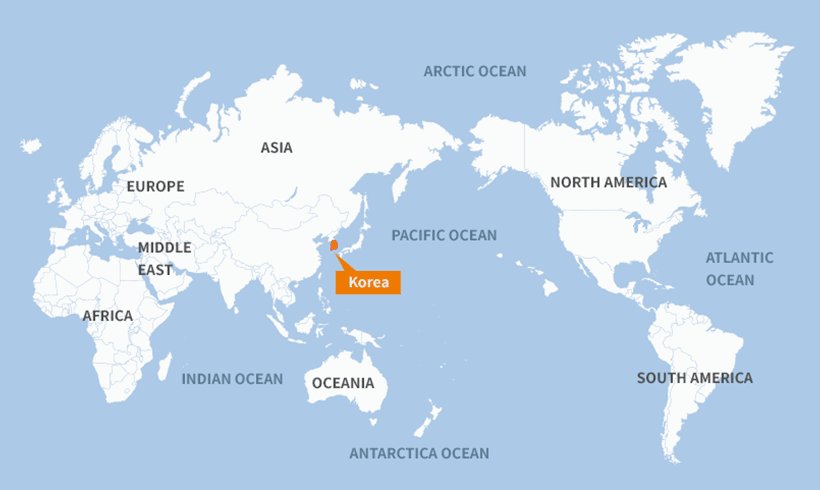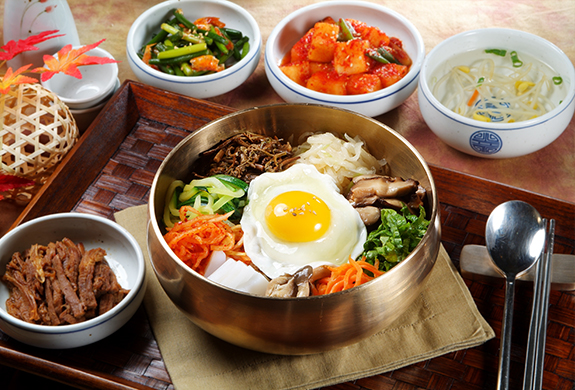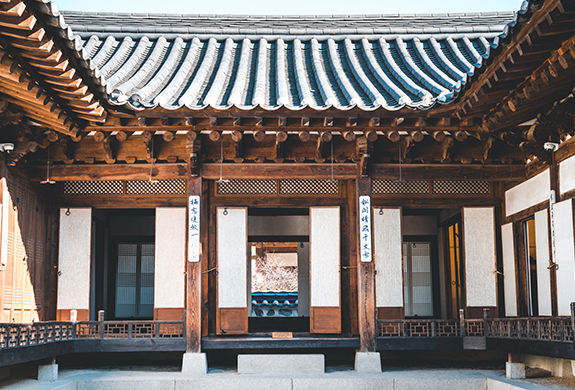Korea & Seoul
Back to the Basic, Go to New Normal
Korea

Korea is a nation that boasts a fast growing economy and a lifestyle that perfectly combines the old and the new. Once known as "the Land of the Morning Calm", the peninsula now hardly rests, pulsating with life and commerce. In particular, Korea has a very advanced and modern infrastructure and is a world leader in information technology such as electronics, telecommunications, semiconductors, LCD displays, computers, cell phones and high-tech gadgets, led by global companies such as Samsung and LG. It is also home to such world famous car companies as Hyundai and Kia, which help to make the country one of the world's top five automobile manufacturers. Indeed, Korea is a major global economic power and it has been one of the most successful and fastest growing economies in the world since the 1960s, now 13th largest in the world. Korea also plays a key role in international trade as years of rapid economic development propelled the country into becoming the world's seventh largest trading nation. It is also the world's largest shipbuilding nation and the world's third largest steel producing country.
In addition, many global events have been taken place here including the 2012 Seoul Nuclear Security Summit, the G20 Seoul Summit 2010, the APEC Summit 2005, the 2020 FIFA Football World Cup, and the 1988 Seoul Olympic Games, while the city of Pyeongchang will host the 2018 Winter Olympics.
Despite all such enthusiasm for modernization and globalization, Koreans still greatly value their 5,000 years of history and beautiful nature, making their country an attractive destination for business travelers and vacationers alike. Meanwhile, the "Korean Wave", also known as "Hallyu" is taking the world by storm as Korean pop culture has been greatly gaining its popularity overseas. Amidst the Korean Wave, famous spots that appeared in Korean dramas and movies attract foreign visitors all year around. Korea's long heritage and inspiring scenery impress all visitors with uniqueness and charm. Please visit Korea and discover the many wonders Korea has to offer.
For further information, please visit http://english.tour2korea.com

HANGEUL Korean Language
Hangeul was invented by King Sejong in 1446 with assistance from some scholars to give the people an alphabet that was easy to read and write. Throughout the world, there are some 3,000 spoken languages but roughly only 100 alphabets. Among these, only hangeul was systematically invented without influence from any other languages.
Hangeul is a very scientific alphabet and is designated by UNESCO as an important part of the Memory of the World Heritage. As a result of the Korean Wave and Korea’s economic prosperity, desire to learn hangeul is exploding.

HANBOK Korean Traditional Clothes
Hanbok is the traditional attire of the Korean people. Worn daily up until just 100 years ago, these days it is only worn on festive occasions or special anniversaries. It is a formal dress and most Koreans keep a hanbok for special times in their life. While the traditional hanbok was beautiful in its own right, the design has changed slowly but surely over the generations. The core of hanbok is its graceful shape and vibrant colors, which have had a major impact on the modern fashion industry. It is hard to think of hanbok as everyday wear but it is slowly being revolutionized through the changing of fabrics, colors and features, reflecting the public's desires. Many aspiring hanbok designers have altered hanbok for everyday wear with traditional elements at the basis of the garment but having a distinct modern feel.

HANSIK Korean Traditional Foods
Hansik refers to traditional Korean food, as well as the manners and rules required in serving them beautifully. What makes Korean food culture different from the rest of the world is mainly the representation of diverse side dishes, served alongside a simple bowl of rice or subtitutory stable food. This composition of rice and various complementary ingredients makes a highly balanced meal, providing all the many nutrients that the average person requires in a day, thus adding one more reason to enjoy hansik daily for your healthy diet!

HANOK Korean Traditional Houses
Hanok refers to houses built in the traditional Korean style. While tile-roofed and thatch-roofed hanoks were equally common in the past, these days hanok generally refers to tile-roofed houses.
There are two main charms to hanoks. The first is the unique heating system of 'ondol.' When hanoks are built, a layer of stone is laid down above the foundation. The heat from the kitchen fire runs through this open space, warming the stone above. This heat spreads up into every room throughout the house, keeping both the floor and the air surprisingly warm in winter. The second attractive point to hanok houses is that they are environmentally-friendly. The materials needed to build a hanok house can be obtained directly from nature. The columns, rafters, doors, windows, and floor are wooden, while the walls are a mixture of straw and dirt. The paper to cover the doors and windows was made from tree pulp. Because the building materials are all natural, hanok houses have excellent breathability, perfect for escaping the summer heat. This is also said to help in the treatment of atopic dermatitis and other modern skin diseases.
Required documents and preparation for Foreigners
- Koreans and foreigners who do not hold a certificate of negative PCR test result for COVID-19 (including those who hold a non-conforming certificate) shall be restricted from getting on board the aircraft.(Regardless of vaccination status)
- * However, if the certificate of negative PCR test result for COVID-19 is found non-conforming after arrival in Korea, the Koreans shall be put to 5-day facility quarantine (at their own expense) plus 2-day self-quarantine, and the entry of the foreigners shall be refused.
- ※ As to the entrants who are exempted from submitting a certificate of negative PCR test result, refer to 'FAQ related to Submission of a Certificate of Negative PCR Test Result'. FAQ related to Submission of a Certificate of Negative PCR Test Result
- Instructions on how to use the pre-entry quarantine information system Q-code Website
- Complete implementation for travelers arriving at International Airport, with future plans of extending to ports.
- Q-CODE system users are not required to submit a health status questionnaire or a special quarantine report (verified by the system)
※ Details, including who can use the system and how to use it, are available at https://cov19ent.kdca.go.kr
- Conduct a Rapid Antigen Test (RAT) on the sixth or seventh day following the arrival date.
- (RAT) By self-examination or visit medical facilities or screening clinics
* However, entrants from overseas aged 60 and over can undergo PCR testing at screening clinics of public health centers - Maintain the current status for persons in facility quarantine (Conduct a PCR test on the sixth or seventh day)
- (RAT) By self-examination or visit medical facilities or screening clinics
- Quarantine exemption for people who have completed vaccinations
| Section | Input quarantine information via pre-entry system (Q-code) | ||
|---|---|---|---|
| ① Arrival Information | ② Vaccination History | ③ Certificate | |
| Entrants who have completed vaccination in Korea | Direct entry of passport number, etc. | Automatic link of vaccination history | Not required to attach a certificate |
| Entrants who have completed vaccination abroad | Direct entry of passport number, etc. | Automatic link of vaccination history | Not required to attach a certificate |
※ Definition of individuals who have completed vaccination
- (Those who completed vaccination in Korea) Refers to an individual who has completed the second vaccination as of the date of admission into Korea or who has completed the third (booster) vaccination following the second vaccination and can verify the immunization history
- * 14 to 180 days following the second dosage of a vaccination (1st dose for Janssen) that has been approved in Korea
- (Verification) After putting information into the pre-entry system for quarantine information (Q-CODE), check vaccination history using the given QR code.
* Those who have completed vaccination in Korea are immediately enrolled in the pre-entry system (You do not have to attach a certificate)
- (Verification) After putting information into the pre-entry system for quarantine information (Q-CODE), check vaccination history using the given QR code.
-
(Those who completed vaccination ouside of korea) Refers to an individual who has received the second vaccination* from outside the country as of the date of entrance or who has received the third (booster) vaccination following the second vaccination and can verify the immunization history.
* 14 to 180 days following the second dosage of a vaccine (1st dose for Janssen) that has been approved by WHO- (Verification) After putting information into the pre-entry system for quarantine information (Q-CODE), check vaccination history using the given QR code.
* Those who have completed overseas vaccination are required to attach a certificate of immunization history to the pre-entry system
- (Verification) After putting information into the pre-entry system for quarantine information (Q-CODE), check vaccination history using the given QR code.
※ 'Those who have completed vaccination outside of korea' are treated the same as 'those who have completed vaccination in Korea' when providing their vaccination history registered in the domestic vaccination certification system via visit to a public health facility before the date of entrance.
Information on this website is only for reference. Please refer to airlines notices, Korea Disease Control and Prevention Agency COVID-19 website, Ministry of Foreign Affairs Travel Safety website or diplomatic offices website for more information.
PCR Negative Test Result
- All Passengers entering Korea are required to submit a PCR negative test result (Print) tested within 48 hours prior to departure date.
- Children(under 6 years of age) are not required to present a PCR test result.
- Test type : Tests based on DNA amplification (RT-PCR, LAMP, TMA, SDA, NEAR, etc.) are valid; antigen/antibody detection tests (RAT, ELISA, etc.) are not valid.
- The test result method must be written in English or Korean. (In case of other languages, a translation certificate must be accompanied)
Symptomatic Entrants
| Classification | PCR test | Test result | Action |
|---|---|---|---|
| Sympto- matic entrants | Arrival Hall or Central Quarantine and Medical Support Center (Quarantine Facility) |
Positive | Transfer to one's residence, hospital, or treatment facility |
| Negative | The procedure for the asymptomatic entrants shall be followed by object. (It shall be considered that the PCR test to be conducted within 1 day after the entry has been completed.) |
Asymptomatic Entrants
- Entrants from Normal Countries
| Classification | Certificate of Negative PCR Test Result | PCR Test within 1 day after Entry | Quarantine | Additional Test | |
|---|---|---|---|---|---|
| Entrants who have completed vaccination | Koreans/ Long-stay Foreigners | Submitted (Conforming) |
Public Health Center | Exempted from quarantine after negative confirmation (Manual monitoring) |
Conduct RAT on the sixth or seventh day |
| Short-stay Foreigners | Submitted (Conforming) |
Incheon Airport COVID-19 Test Center or Medical Institution (own expense) |
Exempted from quarantine after negative confirmation (Manual monitoring) |
Conduct RAT on the sixth or seventh day | |
| Others | Koreans/ Long-stay Foreigners | Submitted (Conforming) |
Public Health Center | Self quarantine for 7 days | RAT on the sixth or seventh day |
| Short-stay Foreigners | Submitted (Conforming) | Test in a temporary residential facility and facility quarantine for 7 days (expenses for 7-day quarantine facility to be covered by the entrants) |
PCR test on the sixth or seventh day | ||
※ Vaccination certificates can be printed from 'Vaccination Aid Homepage (nip.kdac.go.kr), or government 24 (www.gov.kr)' and vaccination certificates can be issued only in a Public Health Center.
※ Transportation: You can take public transportation from the airport to your home.
Holders of a Quarantine Exemption Certificate
※ As to the details, the 「Guidelines for Issuance of Quarantine Exemption Documents to Overseas Entrants」 of the Central Disaster and Safety Countermeasure Headquarters shall be followed.
※ The case of an entrant who holds an A1 (Diplomatic affairs), A2 (Government affairs), or A3 (Treaty) visa, or for whom a 'quarantine exemption document' is issued by a Korean embassy (or the related ministry) before the entry, etc.
| Classification | Certificate of Negative PCR Test Result | PCR Test within 1 day after Entry | Quarantine | Additional Test |
|---|---|---|---|---|
| Submission of the Quarantine Exemption Document | Submitted (Conforming) | Temporary residential facility | Exemption of quarantine after negative PCR test result is checked * Installation of self-diagnosis app |
Conduct RAT on the sixth or seventh day |
※ For all the entrants to whom the SOFA is applied (US Armed Forces in Korea, related persons), PCR tests shall be carried out in a camp of the US Armed Forces in Korea.
※ Those who have completed vaccination among holders of Visa A may submit to a PCR test on their first day in the country at the same location as those who have completed vaccination as indicated above.

